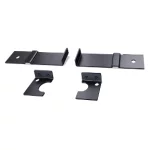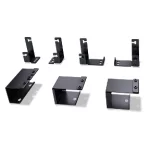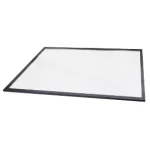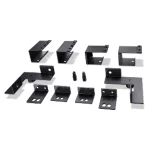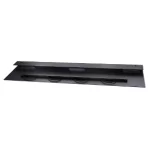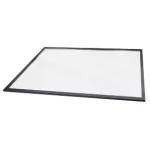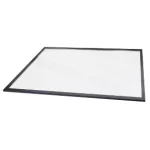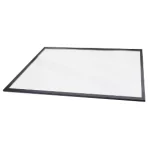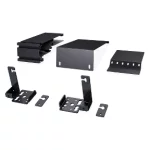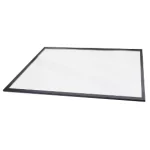Cold aisle containment is designed to eliminate hot spots in server racks, allows more space within the server rack to be used and reduce overall cooling cooling costs. Cold-aisle containment can be used with raised access floor plenums and/or overhead ducted supplies to improve cold airflow to the server racks. The plenum is then open space between the structural concrete slab and the underside of the raised access floor system. As well as for cooling, the plenum may also be used for cable runs via conduits.
Data Centre Aisle Containment Systems
A data centre aisle containment system separates the supply of the cold air and hot exhaust air return paths. Aisle containment helps to ensure a stable and temperature & humidity controlled environment, ensuring cool air is supplied to the IT server intakes, normally via underfloor vented floor tiles or in-row precision cooling units) and the hotter exhaust air is returned in a separate path to the cooling system infrastructure. Server Room Environments provides a complete turnkey package from design to installation and commissioning, for new builds, refurbishment and retrofit projects. In addition to the design and installation of complete containment systems and power optimised data centres (PODs), Server Room Environments also supplies parts & accessories for containment systems.
Hot and Cold Aisle Containment Solutions
There are two forms of containment system available. One for the cold side and one for the hot aisle (hot aisle containment). An installation may use one or both types of containment to prevent hot and cold return air paths mixing. The most commonly installed form of containment is a cold-aisle.
Installing an aisle containment system within a server room or data centre will improve the overall cooling operation and energy efficiency. This in turn can can free-up cooling capacity and reduce the need for additional air-based CRAC units or liquid-based cooling system during unexpected ambient temperature rises, changes in server utilisation or server expansion.
Data Center Aisle Containment Benefits
Aisle containment systems provide a number of advantages including:
- Increased operational of the cooling system by up to 30% or more
- Reduced bypass airflow rate and ‘hot-spots’ within server racks
- Reduced need for additional air conditioning units when loads
- Increased server rack density and in-rack server population
- Increased return temperatures to reduce cooling energy
- Improved energy efficiency and a lower PUE ratio
- Prevents cold and hot air supplies mixing
- Reduced air volumes to save fan energy
- Extended equipment working life
- Improved airflow management
- Lower carbon emissions
Cold Aisle Containment Systems for Cooling
Cold aisles are designed to improve the cooling of server racks and network cabinets. The containment system restricts and routes the flow of cold air, preventing it mixing with the hot air flow within the server room or data centre. The cold air flow becomes more uniform and predictable and can help to eliminate ‘hot spots’ whilst improving energy efficiency.
A cooling side containment system can consist of a hard roof and partitions with single or double sliding doors, soft partitions with strip doors and directional airflow panels. The containment system can be configured as needed for the site in terms of the number of server cabinets it is to house.
Cold area containment can also help to improve server rack utilisation. The top of most server racks (approximately 15%) is left unpopulated due to hot air recirculation. Placing IT servers within this area can lead to reduced operational reliability. Cold containment eliminates ‘hot-spots’ within racks and cabinets, allowing for fuller population if required.
For server rooms and data centres, cold aisle containment can lead to improved return on investment (ROI), server rack density improvements, increased revenue per square meter and improved energy efficiency.
Hot Aisle Containment Systems
Hot aisle containment is designed to guide hot exhaust air flow away from the server room or data centre working space, to the air conditioning return path. In addition to preventing the hot air from mixing with the cold air flow, the overall room ambient is lowered to create a more comfortable working environment.
Hot aisle containment works on the thermal properties of warm air. The containment directs the rising warm airflow to the air conditioning return via a ceiling void or plenum or duct work. The raised access floor plenum is used to direct cooled air to the IT server racks from the cooling system.
By containing the hot air, the cooling system can become more efficient by up to 30% or more. As the hot air remains relatively dry (low humidity), its temperature can be more more effectively lowered by the cooling system. AC fans also tend to run slower, again helping to improve efficiency and extend their operational lifetimes. The overall effect is a more effective and energy efficient cooling system, with the potential for capacity free for future expansion.
Suspended Aisle Containment Solutions
In a suspended aisle containment installation, the containment is suspended from the structural ceiling. This form of containment is popular in some hyperscale data centres. Suspended aisle containment provides a uniform, modular build approach for data centres to scale and roll-out ‘on demand’. The PODs are created in advance and populated with server racks, at a later date fully or partially. If partial, modular rack infill panels can be used to ensure efficient airflow management and operation of the containment system.
Modular Containment
Modular containment systems provide a fast and easy way to install containment within minutes. A standard modular solution can deliver the similar benefits and efficiencies as a bespoke solution, and this type of containment is popular for constantly changing installations or where the number of permanent server racks is too low for the investment in a project specific containment solution.
Airflow Management
Data center containment is one of the most cost-effective ways to manage airflow and improve cooling efficiency. Whether you are looking at hot aise containment or cold aisle containment or PoD system contact our projects team for a design review.
AKCP Digital Twins and Bespoke Ailse Containment System Designs
Our design team provides 2D and 3D models to help you visualise your aisle containment solution, with augmented reality (AR) views if required. A Digital Twin can also be generated for existing systems using an AKCP environmental monitoring and modelling software to allow an assessment of how a refurbished or reconfigured containment system will operate.
Creating a Digital Twin provides a way to model the behaviour of a containment design. Using cooling data, the model provides a way to simulate, information check and predict performance, reliability, cooling and energy efficiency.
For data center operators, digital twins provide several benefits. These include an insight into how equipment cooling solutions and containment are performing. Operators and data center facilities managers can use the model plan for capacity change and identify areas for improvement in terms of cooling efficiency and management of warmer, hotter air paths.
To create a digital twin, the first step is to create a virtual model of the physical space and containment POD. Using a POD simplifies the model and helps to create a more accurate Digital Twin. AKCP environmental monitoring software (AKCPro Server) includes digital twins for popular containment PODs to help save time and make it easier to set up a digital twin simulation.
For more information on our data centre containment solutions please contact our projects team.

Earn SRE points on all online purchases with double points on selected products





























